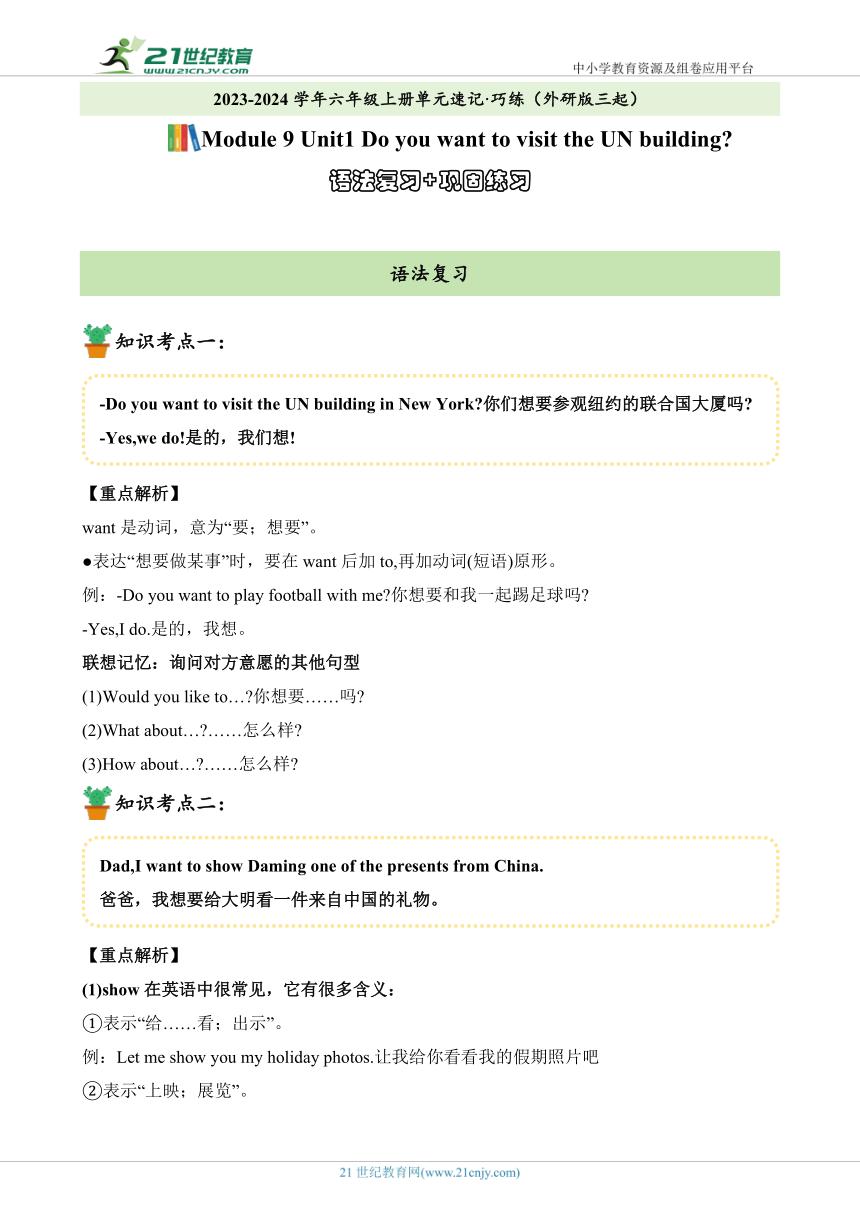
2023-2024 学年六年级上册单元速记·巧练(外研版三起) Module 9 Unit1 Do you want to visit the UN building 语法复习+巩固练习 语法复习 知识考点一: -Do you want to visit the UN building in New York 你们想要参观纽约的联合国大厦吗 -Yes,we do!是的,我们想! 【重点解析】 want 是动词,意为“要;想要”。 ●表达“想要做某事”时,要在 want 后加 to,再加动词(短语)原形。 例:-Do you want to play football with me 你想要和我一起踢足球吗 -Yes,I do.是的,我想。 联想记忆:询问对方意愿的其他句型 (1)Would you like to… 你想要……吗 (2)What about… ……怎么样 (3)How about… ……怎么样 知识考点二: Dad,I want to show Daming one of the presents from China. 爸爸,我想要给大明看一件来自中国的礼物。 【重点解析】 (1)show 在英语中很常见,它有很多含义: ①表示“给……看;出示”。 例:Let me show you my holiday photos.让我给你看看我的假期照片吧 ②表示“上映;展览”。 例:The movie is being shown now.这部影片目前正在上映。 ③表示“带到;带领”。 例:May I show you to the bus station 我可以带你去公共汽车站吗 ④表示“证明;表明”。 例:They think I can't do it,but I'll show them.他们认为我做不了,但是我要证明给他们看! 含有 show 的习惯用语: ①show one's face 意为“露面;到场”。 例:She stayed at home,afraid to show her face.她待在家里,不敢露面。 ②show one's hand 意为“摊牌;公开自己的意图”。 例:He showed his hand at the meeting at last.最后,他在会上亮出了底牌。 ③show off 意为“卖弄;炫�———�。 例:Don't look at him!He's just showing off.别看他!他只是在炫耀。 (2)one of the presents 意为“(其中)一件礼物”,"one of+名词复数”意为“……之一”,通常指多个 人或物中的一个。”one of+名词复数”作主语时,后面的谓语动词用单数。 例:One of my friends is here.我的一个朋友在这里。 知识考点三:what 引导的感叹句 What a big building! 好高大的建筑物! 【句型结构】What a/an +形容词+ 可数名词单数(+主语+谓语)! 感叹句通常由 what 或 how 引导,用以表示惊叹、赞美、喜悦等强烈的情感。 由 what 引导的感叹句,主要有两个句式结构: (1)What a/an(+形容词)+ 可数名词单数(+主语+谓语)! 例:What an interesting story it is. (2)What(+形容词)+ 可数名词复数/不可数名词(+主语+谓语)! 例:What beautiful flowers they are. (3)在口语中,感叹句常常使用省略形式,即省略主语和动词。 例:What red apples! 知识考点四:描述有某人/某物的句型:there be 句型 There are flags from all around the world. 有来自世界各地的旗帜。 There be 句型用来表达“有”,be 要与其后的名词在数上保持一致,如果 be 后接两个或两 个以上的名词,be 的形式要与离它最近的名词在数上保持一致,即就近原则。 (1)肯定句:There is/are +某人/某物(+其他)。 例: There is a cat and some flowers on the table. There are some flowers and a cat on the table. (2)否定句:There is/are +not+某人/某物(+其他)。 例: There aren’t any children in the park. 注意:肯定句中的 some 转换成否定句时,要变为 any。 (3)一般疑问句:Is/Are there +某人/某物(+其他)? 肯定回答:Yes, there is/are. 否定回答:No, there is/are not. 例: Are there two birds in the tree 巩固练习 一、选词填空。 1.It’s cold. You should wear (warm / cold) clothes. 2.It’s time (to get / getting) ... ...
~~ 您好,已阅读到文档的结尾了 ~~